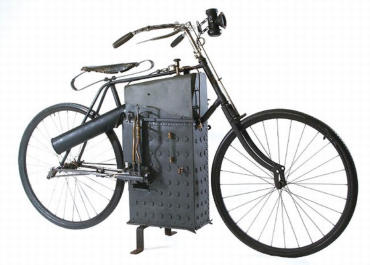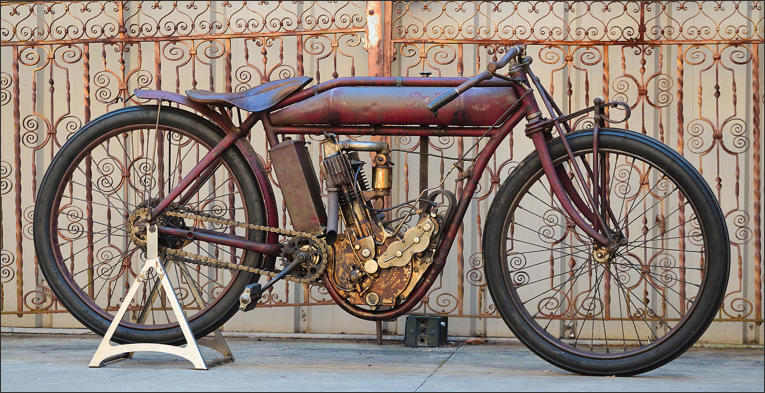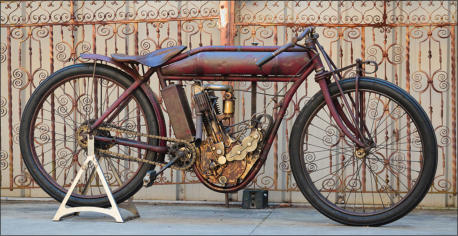



Good question, but I have to ask you one; gas or steam? No, that's not what my Dental Hygienist asks me
before she sets to work cleaning my gnashers. You see Gottlieb Daimler invented the first gas powered
motorcycle in 1885, when an engine created by Nicolaus August Otto was attached to a wooden bicycle.
Just to clarify things here; 'gas' is not a reference to gasoline, but fuel in a gaseous state rather than liquefied.
As two extra wheels were used on this bike as stabilizers, the more pedantic amongst you will disqualify this
vehicle as being a four-wheeler, but let's be fair; he didn't have a lot to go on did he?
So that's it then. Germany takes the glory; Daimler invented the
motorbike........no,no,no. There's a dispute, for eighteen years earlier
in 1867 an American, Sylvester Howard Roper invented a
two-cylinder steam driven motorcycle. It had a forged iron
and hickory frame and iron shod wooden wheels which
must have provided a very uncomfortable ride.
I don't know how practical this machine was, but suffice to
say, it was powered by coal. The firebox and boiler were
suspended on springs from the frame between the wheels,
so I suppose it was just the job for commuting work on those
cold January mornings. Some people consider this to be the first
motorcycle. I'm going to leave you to argue amongst yourselves, but just imagine if the idea had caught on;
today we be talking about MPS or miles per sack, and Barnsley would be awash with money.
Alas, poor Roper came unstuck. In June of 1896 he took his invention to the Charles River bicycle racetrack in
Boston. He had an idea that it would make an ideal pace-making machine for bicycle races. First he completed a
few laps while the best bicycle racers tried to keep up with him, then the track was cleared to allow him to show
just how potent was his machine. His initial attempt covered a mile in two minutes and 12 seconds for an average
speed of about 30 mph.
But why stop at that? He knew his bike would perform at an average speed of 40mph as it had done the previous
week in unofficial tests. However, as he circled the wooden track and his speed increased, the bike began to wobble
causing him to be thrown from the machine. He landing in the sand that surrounded the track, but when worried
onlookers reached him, it was clear that he had expired. His death was not a direct result of the accident, but heart
failure. The announcement of his death was covered in many newspapers including the Boston Daily Globe.
Who Invented the Motorcycle?
A story by Alan Liptrot

Early in the 20th century, motorcycles were being offered for sale to the general public. These were very basic, low
powered machines, devoid of such luxuries as headlights and gears, but nevertheless, motorcycles, and sales rose
year upon year. They were generally started by pedaling,
In 1901, a bicycle racer Oscar Hedstrom designed a motorcycle for the Hendee Manufacturing Company of
Springfield, Massachusetts, which later became the Indian Motorcycle Company. Whilst Daimler and Roper shifted
their attention to cars, a certain William Harley and his friends Arthur and Walter Davidson focused very much on
motorcycles and in 1903, three years after the death of Gottlieb Daimler, the Harley-Davidson Motor Company was launched. Their first bike had a well
powered engine which could prove itself in races, but the boys had other ideas and launched it as a transport vehicle, the first being sold in Chicago
through merchant C.H. Lange.
In the early 20th century and throughout BMW manufactured aircraft engines. In 1923 they launched their first motorcycle, the R32 which reached sales
of 3000 in just three years. This machine became the foundation for future models.
However impractical and cumbersome these early attempts, they were the forerunners of today's machines, and as such we owe a debt of gratitude to
men like Roper and Daimler who provided inspiration for inventors that followed. Roper's steam-powered bicycle still exists in the National Museum of
the Smithsonian Institute of American History.
SHARE WITH US
Copyright © 2025 - Ozark Rides, All Rights Reserved








Copyright © 2025 - Ozark Rides, All Rights Reserved



Good question, but I have to ask you one; gas or steam? No,
that's not what my Dental Hygienist asks me before she sets to
work cleaning my gnashers. You see Gottlieb Daimler invented
the first gas powered motorcycle in 1885, when an engine
created by Nicolaus August Otto was attached to a wooden
bicycle. Just to clarify things here; 'gas' is not a reference to
gasoline, but fuel in a gaseous state rather than liquefied. As
two extra wheels were used on this bike as stabilizers, the more
pedantic amongst you will disqualify this vehicle as being a four
wheeler, but let's be fair; he didn't have a lot to go on did he?
So that's it then. Germany takes the glory; Daimler invented the
motorbike........no,no,no. There's a dispute, for eighteen years
earlier in 1867 an American, Sylvester Howard Roper invented a
two-cylinder steam driven motorcycle. It had a forged iron and
hickory frame and iron shod wooden wheels which must have
provided a very uncomfortable ride. I don't know how practical
this machine was, but suffice to say, it was powered by coal.
The firebox and boiler were suspended on springs from the frame
between the wheels, so I suppose it was just the job for
commuting work on those cold January mornings. Some people
consider this to be the first motorcycle. I'm going to leave you
to argue amongst yourselves, but just imagine if the idea had
caught on; today we be talking about MPS or miles per sack, and
Barnsley would be awash with money.
Alas, poor Roper came unstuck. In June of 1896 he took his
invention to the Charles River bicycle racetrack in Boston. He
had an idea that it would make an ideal pace-making machine
for bicycle races. First he completed a few laps while the best
bicycle racers tried to keep up with him, then the track was
cleared to allow him to show just how potent was his machine.
His initial attempt covered a mile in two minutes and 12 seconds
for an average speed of about 30 mph.
But why stop at that? He knew his bike would perform at an
average speed of 40mph as it had done the previous week in
unofficial tests. However, as he circled the wooden track and his
speed increased, the bike began to wobble causing him to
be thrown from the machine. He landing in the sand that
surrounded the track, but when worried onlookers reached him,
it was clear that he had expired. His death was not a direct
result of the accident, but heart failure. The announcement of
his death was covered in many newspapers including the Boston
Daily Globe.
Who Invented the Motorcycle?
A story by Alan Liptrot

Early in the 20th century, motorcycles were being offered for sale
to the general public. These were very basic, low powered
machines, devoid of such luxuries as headlights and gears, but
nevertheless, motorcycles, and sales rose year upon year. They
were generally started by pedaling,
In 1901, a bicycle racer Oscar Hedstrom designed a motorcycle
for the Hendee Manufacturing Company of Springfield,
Massachusetts, which later became the Indian Motorcycle
Company. Whilst Daimler and Roper shifted their attention to
cars, a certain William Harley and his friends Arthur and Walter
Davidson focused very much on motorcycles and in 1903, three
years after the death of Gottlieb Daimler, the Harley-Davidson
Motor Company was launched. Their first bike had a well
powered engine which could prove itself in races, but the boys
had other ideas and launched it as a transport vehicle, the first
being sold in Chicago through merchant C.H. Lange.
In the early 20th century and throughout BMW manufactured
aircraft engines. In 1923 they launched their first motorcycle,
the R32 which reached sales of 3000 in just three years. This
machine became the foundation for future models.
However impractical and cumbersome these early attempts, they
were the forerunners of today's machines, and as such we owe a
debt of gratitude to men like Roper and Daimler who provided
inspiration for inventors that followed. Roper's steam-powered
bicycle still exists in the National Museum of the Smithsonian
Institute of American History.



MENU




